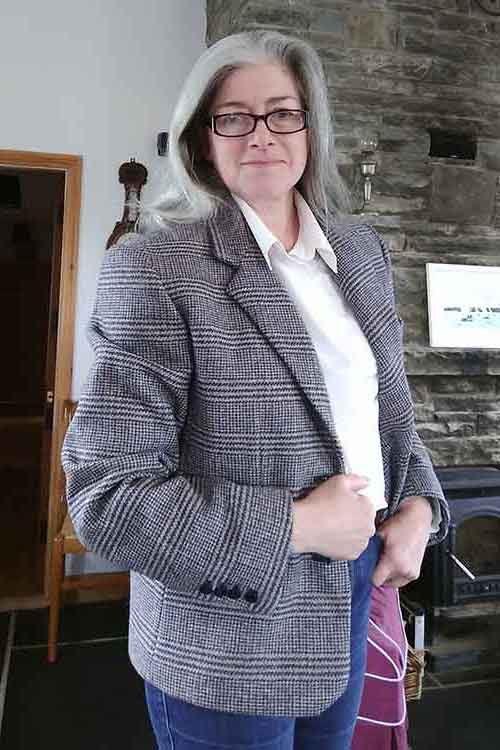
So, I left you looking at an unfinished jacket, Claire Shaeffer’s Vogue pattern V9099, without sleeves or lining, and there was clearly a bit of work to do before the Mallow College of Design and Tailoring fashion show on 1st June.
I had intended to use a plain lining but, having put so many hours into the construction, plain acetate lining didn’t seem to quite fit the bill, so I bought a silky patterned lining from myfabrics.co.uk, one of my most useful suppliers. Usually, with a jacket or coat, the lining is more or less fully assembled and then stitched into the garment, using a ‘bagging’ method. This involves leaving a gap in one of the seams, machine-stitching the lining to the hem and facings, and then turning the whole thing inside out and hand-stitching to close the seam. Not so with a couture or tailored jacket.
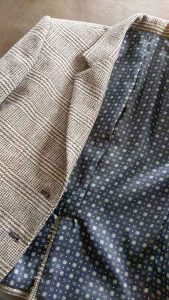 In this jacket, the two halves of the lining are constructed separately; each half consists of a back section, a side panel, and a front section. The panels for each half are stitched and then attached to the corresponding front facing using a running stitch. The facings are then secured to the jacket front with a catch stitch. The side panels of the lining are then secured to the jacket seams with a running stitch and, finally, the jacket is folded in on itself so that the centre back seam of the lining can be sewn. The pattern instructions allowed me to use the machine for that seam!
In this jacket, the two halves of the lining are constructed separately; each half consists of a back section, a side panel, and a front section. The panels for each half are stitched and then attached to the corresponding front facing using a running stitch. The facings are then secured to the jacket front with a catch stitch. The side panels of the lining are then secured to the jacket seams with a running stitch and, finally, the jacket is folded in on itself so that the centre back seam of the lining can be sewn. The pattern instructions allowed me to use the machine for that seam!
And so, onwards. The bottom of the hem was hand-sewn. But, of course. And then we were on to the two-piece sleeves – interfaced with tailor’s canvas at the hem and sleeve head. (The pattern also called for an optional interfacing for the sleeve underarm, but – since it was optional, and there was plenty of body in the tweed – I passed on that one.) The sleeves were set in by hand, using backstitching. The pattern instructions inform me that backstitching is more elastic than machine-stitching and, therefore, more comfortable to wear.
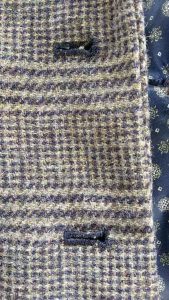 The shoulder pads are slim, compared to the commonly-available foam ones, so I bought in some from a tailoring supply company. They’re constructed in layers of wadding and felt, and so easily customisable.
The shoulder pads are slim, compared to the commonly-available foam ones, so I bought in some from a tailoring supply company. They’re constructed in layers of wadding and felt, and so easily customisable.
With the sleeves in and lined, the jacket is practically finished, save for the buttonholes – also hand-stitched. It’s been years since I hand-stitched a buttonhole – perhaps, not since schooldays? I was pleased with the look of the  jacket, so far, and I’ll confess that I found the idea of slicing into the expensive tweed more than a little terrifying. In the end, though my buttonholes might not stand up to scrutiny from a Savile Row tailor – and after a lot of practice – I’m pretty pleased with them.
jacket, so far, and I’ll confess that I found the idea of slicing into the expensive tweed more than a little terrifying. In the end, though my buttonholes might not stand up to scrutiny from a Savile Row tailor – and after a lot of practice – I’m pretty pleased with them.
OK, so we have a jacket, but the model isn’t going to be happy shimmying down the runway in her knickers, so I needed something to go under it. I had originally planned a fine cotton blouse and a pair of formal indigo-coloured trousers, but my tutor felt that anything ‘too ordinary’ would detract from the work in the jacket.
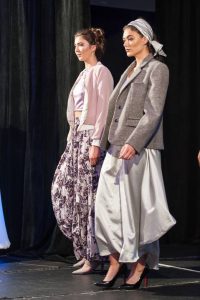
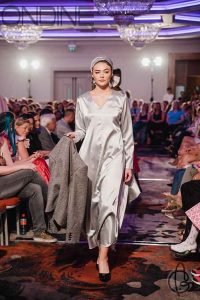
Instead, I decided on Vogue pattern, V9268, by Kathryn Brenne – a plain, fitted, ankle-length dress, with a full, draped skirt, designed for a 2-way stretch fabric. I wanted a bit more shimmer to the dress, and adapted the pattern for a liquid satin with the addition of a zip. I also didn’t go for the bound neckline of the original and added a facing for a sleeker finish.
Both garments were greatly flattered by the slim figure of a professional model …




Sound like wonderful tailoring .think how much better we would look if all our clothes were made as when I was a child of the 60s and early 70s. Everything was comfortable. Well done
For sure, Patricia. But the cost of clothes was also relatively so much higher. There were no Asian sweatshops making up prom dresses and bridal gowns for pennies (or Penneys even LOL). There’s no market for durable quality clothing anymore – wear it once and throw it away. I’ve lost count of the number of people who’ve contacted me to make up a wedding guest outfit, or bridesmaid dress and then expressed horror that I couldn’t even buy the fabric for what they could buy it over the internet!